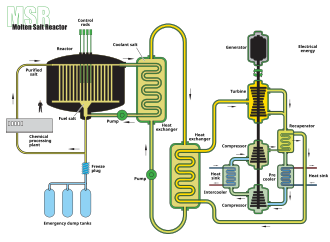Molten-salt reactor
A molten-salt reactor (MSR) is a type of nuclear reactor where the primary coolant or the fuel itself is a molten salt mixture. MSRs are part of the Generation IV reactor designs and are known for their potential to offer safer and more efficient nuclear power.
Design and Operation[edit]

Molten-salt reactors operate at high temperatures and low pressures, using a liquid mixture of salts as the primary coolant. The salts are typically fluorides or chlorides, with lithium fluoride (LiF) and beryllium fluoride (BeF2) being common components, forming a compound known as FLiBe.

The molten salt serves as both the coolant and, in some designs, the fuel carrier. In these designs, the nuclear fuel, such as uranium or thorium, is dissolved in the salt. This allows for continuous reprocessing and refueling, potentially reducing waste and increasing efficiency.
Advantages[edit]
Molten-salt reactors offer several advantages over traditional light-water reactors:
- Safety: The high boiling point of molten salts allows MSRs to operate at atmospheric pressure, reducing the risk of explosive pressure failures. Additionally, the salts are excellent heat conductors, which helps in passive cooling.
- Efficiency: MSRs can achieve higher thermal efficiencies due to their high operating temperatures.
- Fuel Flexibility: MSRs can use a variety of fuels, including thorium, which is more abundant than uranium.
- Waste Reduction: The continuous reprocessing capability of MSRs can reduce the volume and toxicity of nuclear waste.
Challenges[edit]
Despite their advantages, MSRs face several challenges:
- Corrosion: The high-temperature molten salts can be corrosive to reactor materials, necessitating the development of new materials and coatings.
- Complexity: The design and operation of MSRs are more complex than traditional reactors, requiring advanced engineering solutions.
- Regulatory Hurdles: The novel nature of MSRs means they face significant regulatory challenges before widespread adoption.
Historical Development[edit]

The concept of molten-salt reactors dates back to the 1950s, with the Aircraft Reactor Experiment (ARE) being one of the first projects to explore this technology. The ARE was followed by the Molten-Salt Reactor Experiment (MSRE) at Oak Ridge National Laboratory, which operated successfully from 1965 to 1969.

The MSRE demonstrated the feasibility of using molten salts as both fuel and coolant, paving the way for future research and development.
Current Research and Development[edit]
Today, several countries and organizations are pursuing MSR technology as part of their nuclear energy strategies. Notable projects include the Thorium Molten Salt Reactor (TMSR) being developed in China by the Shanghai Institute of Applied Physics (SINAP).
These modern efforts aim to address the challenges faced by earlier designs and capitalize on the potential benefits of MSRs.
Related Pages[edit]
Ad. Transform your life with W8MD's Budget GLP-1 injections from $75


W8MD offers a medical weight loss program to lose weight in Philadelphia. Our physician-supervised medical weight loss provides:
- Weight loss injections in NYC (generic and brand names):
- Zepbound / Mounjaro, Wegovy / Ozempic, Saxenda
- Most insurances accepted or discounted self-pay rates. We will obtain insurance prior authorizations if needed.
- Generic GLP1 weight loss injections from $75 for the starting dose.
- Also offer prescription weight loss medications including Phentermine, Qsymia, Diethylpropion, Contrave etc.
NYC weight loss doctor appointmentsNYC weight loss doctor appointments
Start your NYC weight loss journey today at our NYC medical weight loss and Philadelphia medical weight loss clinics.
- Call 718-946-5500 to lose weight in NYC or for medical weight loss in Philadelphia 215-676-2334.
- Tags:NYC medical weight loss, Philadelphia lose weight Zepbound NYC, Budget GLP1 weight loss injections, Wegovy Philadelphia, Wegovy NYC, Philadelphia medical weight loss, Brookly weight loss and Wegovy NYC
|
WikiMD's Wellness Encyclopedia |
| Let Food Be Thy Medicine Medicine Thy Food - Hippocrates |
Medical Disclaimer: WikiMD is not a substitute for professional medical advice. The information on WikiMD is provided as an information resource only, may be incorrect, outdated or misleading, and is not to be used or relied on for any diagnostic or treatment purposes. Please consult your health care provider before making any healthcare decisions or for guidance about a specific medical condition. WikiMD expressly disclaims responsibility, and shall have no liability, for any damages, loss, injury, or liability whatsoever suffered as a result of your reliance on the information contained in this site. By visiting this site you agree to the foregoing terms and conditions, which may from time to time be changed or supplemented by WikiMD. If you do not agree to the foregoing terms and conditions, you should not enter or use this site. See full disclaimer.
Credits:Most images are courtesy of Wikimedia commons, and templates, categories Wikipedia, licensed under CC BY SA or similar.
Translate this page: - East Asian
中文,
日本,
한국어,
South Asian
हिन्दी,
தமிழ்,
తెలుగు,
Urdu,
ಕನ್ನಡ,
Southeast Asian
Indonesian,
Vietnamese,
Thai,
မြန်မာဘာသာ,
বাংলা
European
español,
Deutsch,
français,
Greek,
português do Brasil,
polski,
română,
русский,
Nederlands,
norsk,
svenska,
suomi,
Italian
Middle Eastern & African
عربى,
Turkish,
Persian,
Hebrew,
Afrikaans,
isiZulu,
Kiswahili,
Other
Bulgarian,
Hungarian,
Czech,
Swedish,
മലയാളം,
मराठी,
ਪੰਜਾਬੀ,
ગુજરાતી,
Portuguese,
Ukrainian